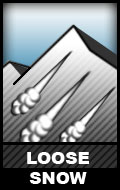Saturday:
The danger rating and information provided below is only intended to be valid for 3/15/14
Click here to view the complete danger scale
About a foot of new snow has fallen in East Anchorage as of 6am this morning – even more is expected in the Front Range and Eagle River area mountains. Temperatures dropped consistently throughout the storm and this is expected to have produced a “right-side up” deposit of fresh snow, all of it relatively low density, but with the lightest stuff at the surface.
Concerns:
Click here to learn more about this type of problem and how to manage it
Wind slabs problems are twofold and may exist on multiple aspects:
1. Small, soft wind slabs in the upper elevations (above 3500′) near peaks and ridge crests formed from the Friday-Saturday storm snow.
2. Denser, possibly more widespread wind slabs formed earlier in the week from several days of strong winds.
Winds in the mountains appear to have been mostly light throughout the Friday-Saturday storm, likely limiting wind slab development from this newest deposit of snow to the upper elevations (above 3500′) near peaks and ridge crests. Winds appear to have shifted and been variable during the storm, so multiple aspects should be suspect for the wind slab problem.
Before the appreciable deposit of drier and lower density snow Friday-Saturday, the snow had been trickling in and winds had been blowing strong all week with little respite. Wind direction shifted numerous times this week; hazards may exist from these now buried and hidden wind slabs formed on multiple aspects earlier this week as well.
While the wind slab problem is expected to be the most pronounced in the upper elevations (above 3500′) near peaks and ridges, the mid elevations (below 3500′) may harbor wind slab problems as well – especially on terrain features like cross-loaded gully sidewalls.
Be mindful as to clues of wind slab distribution and location: cracking, collapsing, areas of more dense snow (especially if on top of less dense, “hollower” snow), and heavily loaded areas with a potentially “bulbous” or “pillowy” appearance.
As wind slabs problems are relatively close to the surface and are underlain by a significantly harder and stout melt-freeze crust, quick assessment via means like pole probing and hand pits should provide relevant and useful information.
Click here to learn more about this type of problem and how to manage it
Where cohesive slabs haven’t formed on steep (>35 degrees) upper elevation (above 3500′) terrain, expect “sluffing” of the new snow received Friday-Saturday. The loose snow avalanche, or sluff, problem will be the most pronounced where the Fri-Sat snow fell directly on top of exposed melt-freeze crusts. While these “sluffs” will be relatively small, consider the consequences of a fall or loss of control.
Click here to learn more about this type of problem and how to manage it
The persistent slab problem, which resides deeper within the snowpack, is a peripheral concern that is very unlikely to be triggered. However, it still can’t be ruled out completed, has been stressed to some extent via loading from the Fri-Sat storm snow, and would be the most inherently consequential type of avalanche to be triggered should one find a pocket of anomalous instability in this regard. While unlikely, the persistent slab problem is more pronounced in the northern advisory area (Arctic Valley and South Fork Eagle River areas).
Mountain Weather:
Cloudy skies are expected, but possibly with partial clearings later today. Currently light snowfall this morning should taper off soon with a chance for snow showers remaining. Mountain temperatures are expected to be in the teens to mid 20s with generally light winds.




